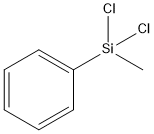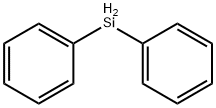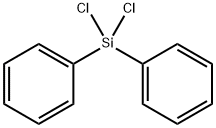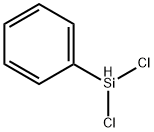Dichloromethylphenylsilane
Synonym(s):Methyl-phenyl-dichlorosilane
- CAS NO.:149-74-6
- Empirical Formula: C7H8Cl2Si
- Molecular Weight: 191.13
- MDL number: MFCD00000490
- EINECS: 205-746-2
- SAFETY DATA SHEET (SDS)
- Update Date: 2025-01-27 09:38:02

What is Dichloromethylphenylsilane?
Description
Dichloromethylphenyl-silane is a flammable,colorless liquid. Molecular weight=191.14; Boilingpoint=205℃; Freezing/Melting point: 2 52.7℃; Flashpoint=82℃. Hazard Identification (based on NFPA-704 MRating System): Health 3, Flammability 3, Reactivity 2 .Reacts with water.
Chemical properties
CLEAR COLOURLESS LIQUID
Chemical properties
Dichloromethylphenylsilane is a flammable, colorless liquid.
The Uses of Dichloromethylphenylsilane
Dichloromethylphenylsilane is used as a monomer (?building block?) in the production of silicone polymers or silicone resins. Silicone polymers may be oils, greases and rubbers. It is also used as an intermediate (starting material) in the production of other organosilicon substances. It is a bifunctional reagent for the preparation of methylphenylsilyl derivatives of diols.
The Uses of Dichloromethylphenylsilane
Manufacture of silicones.
General Description
A colorless liquid. Insoluble in water and denser than water. Flash point between 70-140°F. Corrosive to skin and eyes and may be toxic by inhalation and skin absorption. Used to make other chemicals.
Reactivity Profile
Chlorosilanes, such as Dichloromethylphenylsilane, are compounds in which silicon is bonded to from one to four chlorine atoms with other bonds to hydrogen and/or alkyl groups. Chlorosilanes react with water, moist air, or steam to produce heat and toxic, corrosive fumes of hydrogen chloride. They may also produce flammable gaseous H2. They can serve as chlorination agents. Chlorosilanes react vigorously with both organic and inorganic acids and with bases to generate toxic or flammable gases.
Hazard
Flammable, moderate fire risk, reactsstrongly with oxidizing materials. Irritant.
Health Hazard
The chemical is toxic and is an irritant. Contact may cause burns to the skin and eyes.
Fire Hazard
When heated to decomposition, Dichloromethylphenylsilane emits toxic fumes of chlorine-containing compounds. Flammable/combustible material; may be ignited by heat, sparks, or flames. Vapors may travel to a source of ignition and flash back. Container may explode in heat of fire. Vapor explosion hazard indoors, outdoors or in sewers. Runoff to sewer may create fire or explosion hazard. Fire may produce irritating or poisonous gases. Reacts strongly with oxidizing materials.
Flammability and Explosibility
Not classified
Safety Profile
Poison by inhalation, subcutaneous, and intraperitoneal routes. Corrosive to eyes, skin, and mucous membranes. Flammable liquid. When heated to decomposition it emits toxic fumes of Cl-. See also CHLOROSILANES.
Potential Exposure
Used in the manufacture of silicones; and as a chemical intermediate for silicone fluids, resins, and elastomers
First aid
If this chemical gets into the eyes, remove anycontact lenses at once and irrigate immediately for at least15 min, occasionally lifting upper and lower lids. Seek medical attention immediately. If this chemical contacts theskin, remove contaminated clothing and wash immediatelywith soap and water. Seek medical attention immediately. Ifthis chemical has been inhaled, remove from exposure,begin rescue breathing (using universal precautions, including resuscitation mask) if breathing has stopped and CPR ifheart action has stopped. Transfer promptly to a medicalfacility. When this chemical has been swallowed, get medical attention. If victim is conscious, administer water ormilk. Do not induce vomiting.
Storage
Color Code—White: Corrosive or Contact Hazard;Store separately in a corrosion-resistant location. Prior toworking with methylphenyldichlorosilane you should betrained on its proper handling and storage. Store in tightlyclosed containers in a cool, well-ventilated area away frommoisture, oxidizers, and ammonia. Where possible, automatically pump liquid from drums or other storage containers to process containers.
Shipping
UN2437 Methylphenyldichlorosilane, Hazard class: 8; Labels: 8-Corrosive material
Purification Methods
Methylphenyl dichlorosilane (dichloro methyl phenylsilane) [149-74-6] M 191.1, b 114 -115o/50mm, 202-205o/atm, d 4 1.17. Purify it by fractionation using an efficient column. It hydrolyses ca ten times more slowly than methyltrichlorosilane and ca sixty times more slowly than phenyltrichlorosilane. [Shaffer & Flanigen J Phys Chem 61 1591 1957, Beilstein 16 III 1211, 16 IV 1517.]
Incompatibilities
Incompatible with oxidizers (chlorates, nitrates, peroxides, permanganates, perchlorates, chlorine, bromine, fluorine, etc.); contact may cause fires or explosions. Keep away from alkaline materials, strong bases, strong acids, oxoacids, and epoxides. Chlorosilanes react vigorously with bases and both organic and inorganic acids generating toxic and/or flammable gases. Chlorosilanes react with water, moist air, or steam to produce heat and toxic, corrosive fumes of hydrogen chloride. They may also produce flammable gaseous hydrogen. Contact with ammonia may form a self-igniting material. Attacks some metals in the presence of moisture
Properties of Dichloromethylphenylsilane
| Melting point: | -53°C |
| Boiling point: | 205 °C(lit.) |
| Density | 1.176 g/mL at 25 °C(lit.) |
| vapor pressure | 0.004-32Pa at 25℃ |
| refractive index | n |
| Flash point: | 181 °F |
| storage temp. | Store below +30°C. |
| form | liquid |
| Specific Gravity | 1.187 |
| color | colorless |
| explosive limit | 0.2-8.6%(V) |
| Water Solubility | reacts |
| Sensitive | Moisture Sensitive |
| Hydrolytic Sensitivity | 8: reacts rapidly with moisture, water, protic solvents |
| BRN | 970975 |
| CAS DataBase Reference | 149-74-6(CAS DataBase Reference) |
| NIST Chemistry Reference | Silane, dichloromethylphenyl-(149-74-6) |
| EPA Substance Registry System | Dichloromethylphenylsilane (149-74-6) |
Safety information for Dichloromethylphenylsilane
| Signal word | Danger |
| Pictogram(s) |
 Corrosion Corrosives GHS05 |
| GHS Hazard Statements |
H314:Skin corrosion/irritation |
| Precautionary Statement Codes |
P280:Wear protective gloves/protective clothing/eye protection/face protection. P363:Wash contaminated clothing before reuse. P303+P361+P353:IF ON SKIN (or hair): Remove/Take off Immediately all contaminated clothing. Rinse SKIN with water/shower. P305+P351+P338:IF IN EYES: Rinse cautiously with water for several minutes. Remove contact lenses, if present and easy to do. Continuerinsing. P405:Store locked up. |
Computed Descriptors for Dichloromethylphenylsilane
| InChIKey | GNEPOXWQWFSSOU-UHFFFAOYSA-N |
New Products
4,4-Difluoropiperidine hydrochloride tert-butyl 9-methoxy-3-azaspiro[5.5]undecane-3-carboxylate Indole Methyl Resin N-Isopropylurea N,N-Dicyclohexylcarbodiimide(DCC) MELDRUMS ACID 5-METHYLISOXAZOLE-4-CARBOXYLIC ACID Magnessium Bis glycinate Zinc ascorbate 1-bromo-2-butyne 2-acetamidophenol 9(10H)-anthracenone Erythrosin B, 4-Piperidinopiperidine 2-((4-morpholinophenylamino) (methylthio) methylene) malononitrile 2,4-dihydroxybenzaldehyde 3-(4-morpholinophenylamino)-5-amino-1H-pyrazole-4-carbonitrile Methyl 2-methylquinoline-6-carboxylate 2,6-dichloro-4-nitropyridine 4-Bromo-2-chlorobenzonitrile 2-(benzylamino)acetic acid hydrochloride 4-(tert-Butoxycarbonylamino)but- 2-ynoic acid 3,4-dihydro-2H-benzo[b][1,4]dioxepine 1-Phenyl-1-cycloprppanecarboxylicacidRelated products of tetrahydrofuran








You may like
-
 Dichloromethylphenylsilane, 98% CAS 149-74-6View Details
Dichloromethylphenylsilane, 98% CAS 149-74-6View Details
149-74-6 -
 Dichloro(methyl)phenylsilane, 98% CAS 149-74-6View Details
Dichloro(methyl)phenylsilane, 98% CAS 149-74-6View Details
149-74-6 -
 Dichloro(methyl)phenylsilane CAS 149-74-6View Details
Dichloro(methyl)phenylsilane CAS 149-74-6View Details
149-74-6 -
 Dichloro(methyl)phenylsilane CAS 149-74-6View Details
Dichloro(methyl)phenylsilane CAS 149-74-6View Details
149-74-6 -
 3-(4-amino-1-oxoisoindolin-2-yl)-1-methylpiperidine-2,6-dione 98%View Details
3-(4-amino-1-oxoisoindolin-2-yl)-1-methylpiperidine-2,6-dione 98%View Details -
 20677-73-0 (2,2-diethoxyethyl)methylamine 98%View Details
20677-73-0 (2,2-diethoxyethyl)methylamine 98%View Details
20677-73-0 -
 3-(4-(hydroxyamino)-1-oxoisoindolin-2-yl)piperidine-2,6-dione 98%View Details
3-(4-(hydroxyamino)-1-oxoisoindolin-2-yl)piperidine-2,6-dione 98%View Details -
 57381-49-4 2-bromo-4-chlorobenzonitrile 98%View Details
57381-49-4 2-bromo-4-chlorobenzonitrile 98%View Details
57381-49-4
